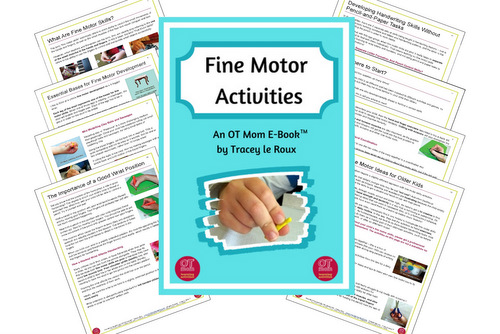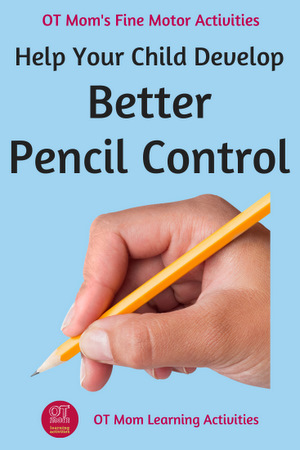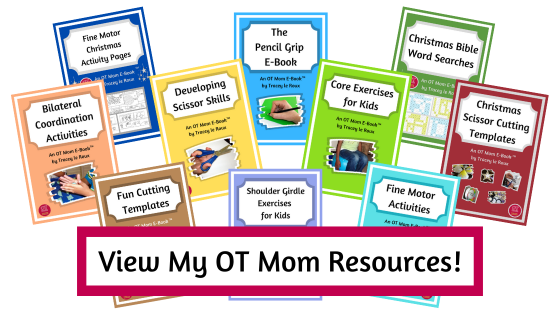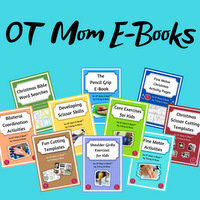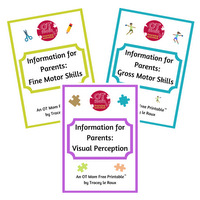- Home Page
- Fine Motor Activities
- Pencil Control Activities and Exercises
Pencil Control Activities
These simple pencil control activities can be used to help improve your child's pencil skills. They make great warm-up finger exercises before a handwriting lesson because they can help your child master the use of a pencil or pen.
Having good pencil control may help your child form letters smoothly and more neatly during handwriting lessons.(*)
I sometimes link to products (#Ad) that are similar to those I use and love. If you do purchase something through my links, I will receive a small commission that helps support my site - thank you!
Some of the exercises on this page focus on in-hand manipulation skills (with a pencil), while others help your child develop the smaller finger movements that are needed for good handwriting.
They are best attempted once your child has developed some degree of
dexterity and skill using the thumb, index and middle fingers together - check out my other fine motor pages if your child needs more basic activities.
These fine motor activities are intended to encourage your child's normal fine motor development. If you suspect your child has fine motor delays, please seek a professional opinion.
1 - Pencil Pops
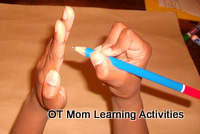 Bend....
Bend....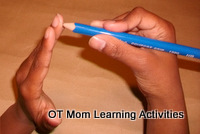 ...and stretch!
...and stretch!Have your child hold the pencil with the tripod fingers, and hold the other hand with the palm facing the pencil.
Ask your child to bend and stretch the fingers to enable the pencil to “pop” over to touch the palm of the other hand and then come back.
Repeat a few times. Aim to increase the number of repetitions as your child improves
This is a good fine motor classroom exercise as a warm up for handwriting!
2 - Pencil Flips / Pencil Somersaults
Use a pencil with an eraser on the end. Or use a fun pencil topper/eraser at the end of the pencil.
Have your child touch the paper with the tip of the pencil, then flip the pencil over in the hand (without using the other hand) to have the eraser/pencil topper touch the page.
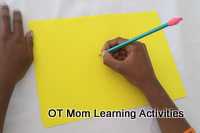 1
1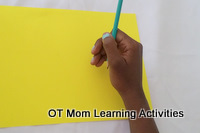 2
2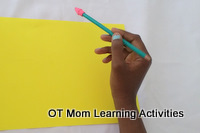 3
3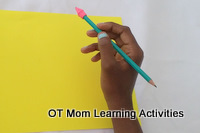 4
4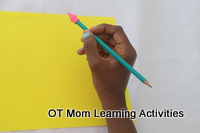 5
5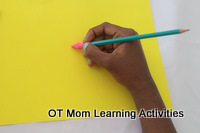 6
6You can also have your child touch the palm of the other hand (as in the exercise above) with first the tip then the eraser.
Flipping the pencil over like this, is a great in-hand manipulation activity that really gives the hand and finger muscles a good workout!
3 - Coloring Small Circles and Grid Pictures
Good handwriting requires that we use small movements of the
fingers to form the letters. Most letters are formed with a combination of curved and straight lines.
Coloring small circles is one way to encourage your child to use small finger movements in a circular direction.
I find it best for the child to first trace the border of the circle and then color it in with circular movements.
I often add small circles as decorative detail on a shape that will be cut out.
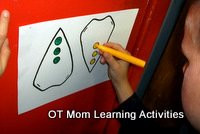 Use finger movements to color small circles
Use finger movements to color small circlesColoring a square on a grid picture can help your child get a back and forth movement of the fingers while coloring one square at a time.
Choose a simple grid picture that has blocks about 1cm square. Have your child color one block at a time using a back and forth/up and down movement of the pencil.
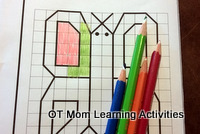 Use finger movements to color small squares
Use finger movements to color small squaresI recommend doing just a few blocks or circles at a time, as these exercises are very tiring for kids who are just mastering pencil control.
TIP: Working on a vertical surface may help your child to rest the wrist on the wall and to isolate the fingers, so that only the fingers are moving.
View the printable dot pictures and grid pictures that I use.
4 - Tracing Spirals
This exercise is an extension of coloring small circles, and may help your child to develop the smaller finger movements that are needed for good handwriting.
Draw some simple spirals going in each direction, and have your child trace over them with a marker or colored pencil. I added some interest by extending the spirals to make snails.
Your child can start on the inside of the spiral and trace out, or on the outside and trace in.
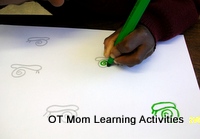 Tracing over small hand drawn spirals
Tracing over small hand drawn spiralsWorking on a vertical surface may help your child isolate the finger movements if the wrist is resting on the surface. Just do a few at a time until your child becomes more proficient.
I include 2 pages of printable spirals in my printable Fine Motor Activities Resource. Check it out!
My Child Struggles With These Pencil Control Activities
If your child struggles to control a pencil, and found these suggestions too challenging, then take a step back. Look for opportunities to spend some time working on strengthening the hand muscles and getting the fingers to work together in fun activities that don't use a pencil.
Here are some of the pages on my site that may help you:
- hand strengthening exercises
- hand and finger exercises for kids in preschool and kindergarten
- additional finger exercises
- more ideas to get the fingers moving
If you or your child's teacher are concerned about your child's fine motor development in comparison to his/her peers, then please do get an occupational therapist evaluation to see how best to help your child.
Or Get My Fine Motor Download!
If the activities on this page were helpful, then check out my printable e-book download!
For the price of a couple of coffees, you can get lots of helpful information as well as more than 24 pages of photographed activities to help support your child's fine motor skills, including pencil control activities!
More Help For Handwriting
Read my article about the 10 Factors Affecting Handwriting to find out what skills can have an impact on your child's handwriting (with links to some helpful activities).
Visual-motor integration and fine motor skills work together to
help your child master good handwriting, so check out my visual motor pages below, for helpful information and simple activities.
Thank you so much for visiting my site! I hope you were helped! Why not sign up for my occasional newsletter to stay in touch with new activities and updated pages as they happen?
- Home Page
- Fine Motor Activities
- Pencil Control Activities and Exercises
Share this page to help others!
References
Cornhill, H; Case-Smith, J. Factors That Relate to Good and Poor Handwriting. 50(9):732-9 · November 1996 http://dx.doi.org/10.5014/ajot.50.9.732
Ohl, A. M., Graze, H., Weber, K., Kenny, S., Salvatore, C., & Wagreich, S. Effectiveness of a 10-week Tier-1 Response to Intervention program in improving fine motor and visual–motor skills in general education kindergarten students. American Journal of Occupational Therapy, 67, 507–514. Sep/Oct 2013 http://dx.doi.org/10.5014/ajot.2013.008110
Weintraub, N. ;Graham, S. The contribution of gender, orthographic, finger function, and visual-motor processes to the prediction of handwriting status. The Occupational Therapy Journal of Research; 20(2):121-140 · March 2000 http://dx.doi.org/10.1177/153944920002000203
Didn't find what you were looking for? Try a search of my site!

